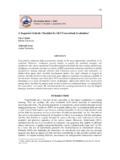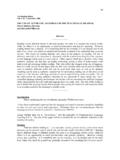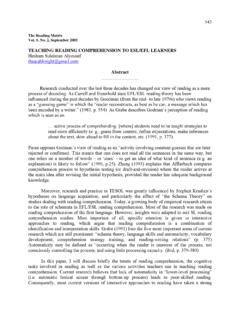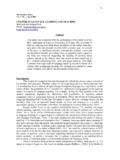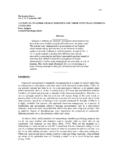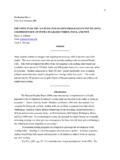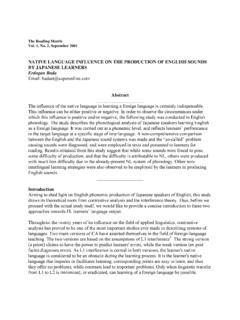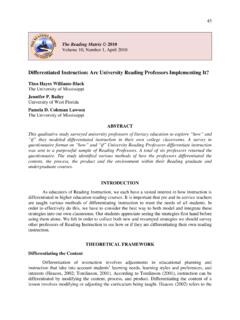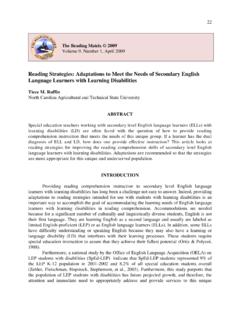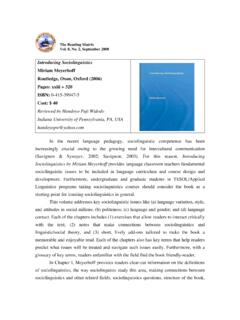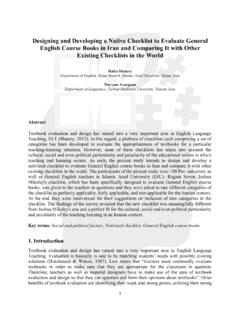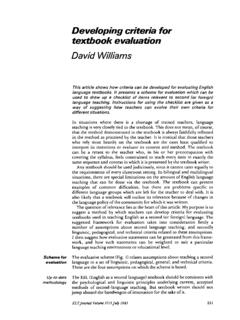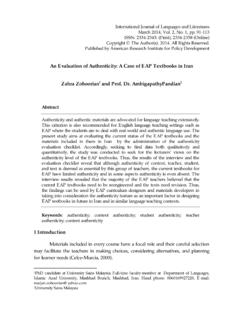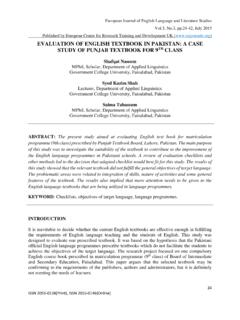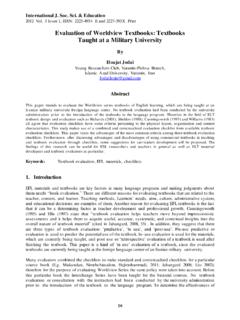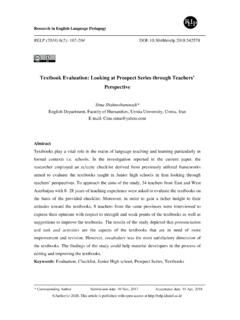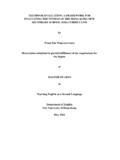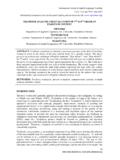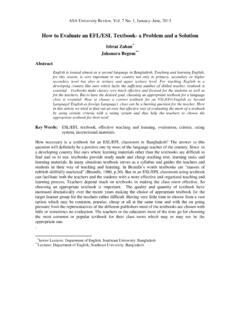Transcription of ESL TEXTBOOK EVALUATION CHECKLIST Abstract
1 The Reading Matrix Vol. 5, No. 2, September 2005 ESL TEXTBOOK EVALUATION CHECKLIST Joshua Miekley Abstract _____ The CHECKLIST in this article provides educators with a valuable tool for evaluating reading textbooks for use in ESL/EFL classrooms. Classroom teachers spend much time using textbooks in class, so choosing an appropriate one is important. Each question in this CHECKLIST is based on either recent research or previously developed checklists. And the article explains how to use the CHECKLIST . Using this will make the TEXTBOOK selection process more efficient and more reliable. _____ While the quality of ESL reading textbooks has improved dramatically in recent years, the process of selecting an appropriate text has not become any easier for most teachers and administrators.
2 Program directors and classroom teachers are under pressure to adopt new reading textbooks on a fairly regular basis, and often on a short notice. While publishers representatives may provide some informed assistance, their need to sell new products clearly influences their recommendations. Since classroom teachers spend a significant amount of time using ESL readers, educators will find the CHECKLIST presented here helpful in making the EVALUATION process more efficient. Traditionally, basal, or graded readers have focused on the sequential teaching of reading skills such as phonics and decoding while being void of authentic material to be read for comprehension (Goodman, Freeman, & Murphy, 1988).
3 Recently, improvements in ESL readers allow students to read more authentic language, read for comprehension, and think critically about reading ( , Interchange, Richards, & Lesley, 2000). However, because of the vast array of textbooks to choose from, the TEXTBOOK selection process often gravitates to one of two extremes. In the process of evaluating textbooks, some educators ask so many questions that they are never able to complete the process. Others choose a reading TEXTBOOK with little or no EVALUATION , yet it becomes the centerpiece of the curriculum until another haphazardly chosen reader replaces it. This CHECKLIST should alleviate both of those types of problems, equipping administrators and classroom teachers with the tool necessary for making an informed EVALUATION of reading textbooks, and balancing the need for thorough EVALUATION with the need for efficiency.
4 This CHECKLIST is based on recent research in second language (L2) instruction and checklists for general TEXTBOOK EVALUATION . For example, research shows that in addition to teaching top-down strategies, graded readers must also provide L2 readers with sufficient examples of these techniques and challenge learners to think critically about what strategies they use (Moran, 1991; Auerbach & Paxton, 1997, Salataci & Akyel, 2002). This CHECKLIST was also constructed using elements of Byrd s (2001) and Skierso s (1991) checklists. The most vital aspect was Byrd s emphasis on the text being a good fit for teachers, students, and the curriculum, all of which are important as educators seek to use materials and methods appropriate to their particular context. Teachers may use this CHECKLIST to make a decision between two potential reading textbooks or a greater number.
5 Begin by assigning a weight (M-Mandatory, O-Optional, or N-Not applicable) to each question while keeping in mind the reader s function in your classroom. This will familiarize you with the questions and assure that your bias for a particular reader does not determine the weight of the questions. Next, peruse the reader. Then, rate it (4-Excellent, 3-Good, ect.) for as many questions as possible. For example, if the reader is full of activities in which students are required to think critically about authentic texts, you could circle 4 (Excellent) for questions , , and (see CHECKLIST ). If you have unanswered questions, scan the reader to find an answer.
6 After completing this process for all the readers you are considering, compare the checklists to determine which reader is the most effective and the best fit for your contexti. While this CHECKLIST is effective as is, educators should add additional questions when appropriate. Also, remember that each context will require you to adapt the CHECKLIST accordingly. For example, vocabulary may be a more important criterion for an ESL teacher whose students will be taking state proficiency tests. If you are evaluating readers for instruction at an international language school where teachers do not have much experience in the TESL/TEFL field, questions pertaining to the teacher s manual should be weighted more heavily. Since reading is so important in second language learning, we must utilize research on L2 reading both in classroom instruction and during the process of selecting a reading TEXTBOOK , and this CHECKLIST can be a valuable asset in accomplishing that goal.
7 TEXTBOOK EVALUATION CHECKLIST I. TEXTBOOK Excellent Good Adequate Poor Totally Lacking Mandatory Optional Not Applicable A. Content i. Is the subject matter presented either topically or functionally in a logical, organized manner? (1,2,3)ii 4 3 2 1 0 M O N ii. Does the content serve as a window into learning about the target language culture (American, British, ect.)? (2,18) 4 3 2 1 0 M O N iii. Are the reading selections authentic pieces of language? (5,10) 4 3 2 1 0 M O N iv. Compared to texts for native speakers, does the content contain real-life issues that challenge the reader to think critically about his/her worldview?
8 (1,2,3,7,21) 4 3 2 1 0 M O N v. Are the text selections representative of the variety of literary genres, and do they contain multiple sentence structures? (1,13) 4 3 2 1 0 M O N B. Vocabulary and Grammar i. Are the grammar rules presented in a logical manner and in increasing order of difficulty? (1,2,3) 4 3 2 1 0 M O N ii. Are the new vocabulary words presented in a variety of ways ( glosses, multi-glosses, appositives)? (2,3,12) 4 3 2 1 0 M O N iii. Are the new vocabulary words presented at an appropriate rate so that the text is understandable and so that students are able to retain new vocabulary? (1,2,3,5) 4 3 2 1 0 M O N iv. Are the new vocabulary words repeated in subsequent lessons to reinforce their meaning and use?
9 (1,2,3,) 4 3 2 1 0 M O N v. Are students taught top-down techniques for learning new vocabulary words? (7,8,9,11) 4 3 2 1 0 M O N C. Exercises and Activities i. Are there interactive and task-based activities that require students to use new vocabulary to communicate? (1,2,3,5) 4 3 2 1 0 M O N ii. Do instructions in the TEXTBOOK tell students to read for comprehension? (6) 4 3 2 1 0 M O N iii. Are top-down and bottom-up reading strategies used? (17) 4 3 2 1 0 M O N iv. Are students given sufficient examples to learn top-down techniques for reading comprehension? (7,8,9,10) 4 3 2 1 0 M O N v.
10 Do the activities facilitate students use of grammar rules by creating situations in which these rules are needed? (1,2,3) 4 3 2 1 0 M O N vi. Does the text make comprehension easier by addressing one new concept at a time instead of multiple new concepts? (2,3) 4 3 2 1 0 M O N vii. Do the exercises promote critical thinking of the text? (2) 4 3 2 1 0 M O N D. Attractiveness of the Text and Physical Make-up i. Is the cover of the book appealing? (1,2,3) 4 3 2 1 0 M O N ii. Is the visual imagery of high aesthetic quality? (1,2,3,14) 4 3 2 1 0 M O N iii. Are the illustrations simple enough and close enough to the text that they add to its meaning rather than detracting from it?
